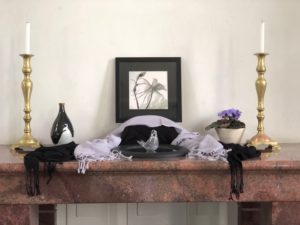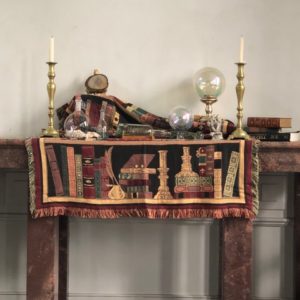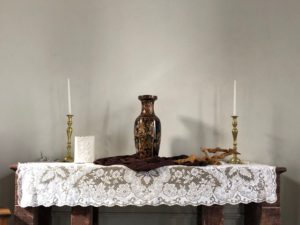This is the text of the reflection I offered on Sunday, June 16, 2019 to the congregation I serve in Charlottesville, Virginia.
A woman is doing some painting in her kitchen. She bumps into a small table and then, in that horrified slow motion way, watches as the jar of paint falls off. When it hits the floor the jar shatters, paint spray hits the wall, and a mess of bright blue glossy enamel spreads across the floor. Looking on this scene the woman says, “Good God …!”
I’m going to leave the story there for a minute, because we’ve all had that experience, haven’t we? Oh, maybe it wasn’t spilled paint, but was, instead, knocking over a display in the grocery store. My kids will never let me forget the year I totally, seriously burned the Thanksgiving turkey. (I mean, the year I made the intentional decision to serve Caribbean blackened turkey.) If ever they think I have forgotten, they pull out the pictures they took. In my defense, I will say that once you cut through the half-inch or so of char, the turkey was pretty moist.
Have you ever meant to save something but somehow accidentally deleted it? Or maybe hit “send” before you meant to? I read about a guy who sent a group text to his friends and co-workers in which he spoke rather unflattering about their boss and told of his plans to pretend to be sick so he could go home and start the weekend early. Unfortunately, he’d forgotten that his boss was part of the group. He ended up with more than a long weekend.
Anybody here not have a story of some monumental screw-up? Back in February I talked about how the theological concepts of “sin” and “grace” are so often completely misunderstood, that the one English word, “sin,” comes from eight different Greek words, many of which are, essentially, acknowledgements that we are prone to making mistakes. “We are all sinners,” then, isn’t a judgmental condemnation. It’s just a statement of fact: we all tend to screw-up. And that means we don’t have to put so much effort into, waste so much of our psychic and spiritual energy, trying to come off as something that we’re not: perfect. We’re all just trying our best, bumping into things, making mistakes, making messes that have to be cleaned up.
So let’s go back to that woman in her kitchen. This story comes from a song by the singer-songwriter David Wilcox. When we left her, she was looking down at the mess on her floor, saying, “Good God …”. But I tricked you. So doesn’t just say, “Good God.” She says, “Good God, look at that pattern! I’ve never seen that before.”
And then she lets the paint stay there on her floor. When it’s dry she paints a white frame around it, installs gallery lighting, and gives it a name: “Kitchen Blue.” And Wilcox tells us that, “rich folks come over for dinner, [and] they all want one of their own. They say, ‘how much?’ ‘‘Who’s the artist?’ and, “My what a beautiful home.’”
The chorus is,
“Leave it like it is.
Never mind the turpentine.
Just leave it like it is.
It’s fine.”
Leave it like it is … it’s fine. And you, and me, we’re fine. Our messes? Our mistakes? Our failings and failures? They’re just part of being human. We don’t have to try to be perfect. We don’t have to try to hide our mistakes.
I’m not saying that there isn’t room for improvement; this isn’t an invitation to keep all of our bad habits. There’s a saying, “God loves you just the way you are … and loves you too much to let you stay that way.” Those of us who, for example, identify or are identified as white — the way we are it isn’t “just fine.” Same, too, for us men. The mess of misogyny needs to be cleaned up. We can’t recognize that we participate in and perpetuate the systems and structures of white supremacy (whether we want to or not) and simply say, “we’re really good people, we’re fundamentally okay and, anyway, we aren’t as bad as those guys carrying tiki torches and waving Confederate and Nazi flags.” No … there are some messes, some mistakes, some “sins” (if you will) that need to be addressed; that do call for the mental, emotional, social, spiritual turpentine. It doesn’t matter how old we are, how set in our ways, how many other good things we’ve done — when we see or are shown the way our mistakes hurt people, it’s still true that we’re “fine” just the way we are. We can’t, though, be content to stay that way.
But let’s look at that song again. The woman doesn’t just notice the spill and decide not to freak out about it. No. She highlights it, frames it, names it, shines a light right on it. And when the “rich folks” come over for dinner she doesn’t throw an area rug over it to “keep up appearances.”
What would that look like? The peace activist, poet, and Buddhist monk the Venerable Tich Nhat Hanh described in one of his books the way interpersonal conflicts are handled in Vietnamese monasteries. When a monk feels hurt by something another monk said or did, the two come together, kneeling face-to-face, very close. The rest of the monks gather around in witness. Then the aggrieved monks began to recount the story of what happened … with each monk focusing on what they themselves did wrong. One might say, “The other day I intruded on your meditation,” and the other might reply, “When you tapped me on the shoulder I shouted at you rather than asking what you needed.” The first could go on, “I should have apologized for the interruption, but instead I started to insult the strength of your practice.” See? One says, “I did …”. The other says, “I did …”. They go on like this, alternating back and forth, until the entire incident has been described, with each person focusing on their own faults first.
Now, the monks could begin by each accusing the other of wrongdoing, each one telling “their side” of the story in order to show what the other person did wrong. That’s how our dominant culture teaches us to handle conflicts — come out swinging, shine a spotlight on the other person’s failings while simultaneously trying to hide or at least minimize our own. Well … how well does that usually work out? That aggressive posture, which is really a defensive posture, almost always just reinforces the differences. We tend to dig in when we feel we’re being attacked. Often, and maybe most often, we’re so busy inventorying the other person’s faults that we don’t even notice our role in the situation. Jesus is remembered as asking,“Why do you look at the speck of sawdust in [the other person’s] eye and pay no attention to the plank in your own […]?”
So, the song (and virtually every real spiritual tradition I know of) tells us that we don’t need to get entangled in the paralyzing worry of what other people will think of us. And we don’t need to try to hide our mistakes, our flaws, once we’ve seen them. It points to the truth that being willing to show them to others is the only way we have any real chance of addressing and correcting them … of making the changes in ourselves that are necessary for real healing.
Now … if that’s all the wisdom to glean from that song, that would be enough. But there’s one more thing. The last verse is:
“Most folks suffer in sorrow,
Thinking they’re just no good.
They don’t match the magazine model
As close as they think they should.
They live just like the paint-by-numbers,
The teacher would be impressed.
A lifetime of ‘follow the lines,’
So they’re just like all of the rest.”
“The mass of [people] live lives of quiet desperation,” is how our Unitarian ancestor Henry David Thoreau put it. To a large extent that’s because we’re trying to stay within the lines, conform to the expected, to behave — and be – the way we’re “supposed” to. There’s a scene in the movie Avengers: End Game (which, if you haven’t seen it yet, first, shame on you, and, second, don’t worry, no spoilers here), after one character confesses with shame to another that they’re really just a failure, the other character responds, “Everyone fails at who they’re supposed to be […]. The measure of a person, of a hero, is how well they succeed at being who they are.”
It takes courage to buck the system, to take the risk of standing out, to be who we are instead of who the world wants us and expects us to be, to, “march to the beat of a different drummer,” quoting Thoreau again. In our bones we know the truth of the Japanese aphorism, “the nail that sticks up is hammered down.” And this thing of openly acknowledging our faults and failings, of paying more attention to them than to the faults and failings we see in others, to, keep clean, “our side of the street,” (as the 12 Step movement puts it) … well … that would make us stick out in a world where we’re encouraged to do anything but. Yet being who we are, who we really are, with all of our follies and foibles, daring to publicly name our “growing edges,” is the key to living a full, rich, and authentic life. All of the great religions of the world assure us of that. And so does David Wilcox.
Oh! One last thing. It turns out that there are people who really have framed and highlighted their mistakes! This is a photo of a hole a man put in the drywall when he fell down the stairs during the first Thanksgiving he and his love spent together. In case you can’t see what’s at the bottom of the photo, it’s a small plaque that reads, “First Thanksgiving, 2015,” and he describes his medium as, “hand, drywall.”
Pax tecum,
RevWik












